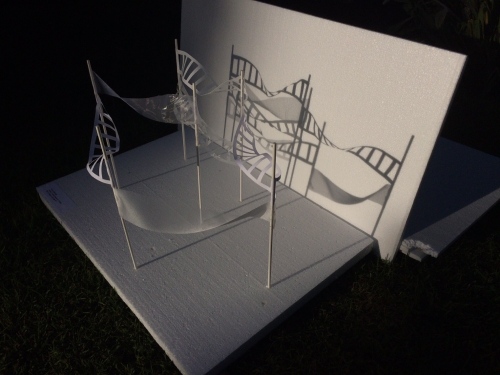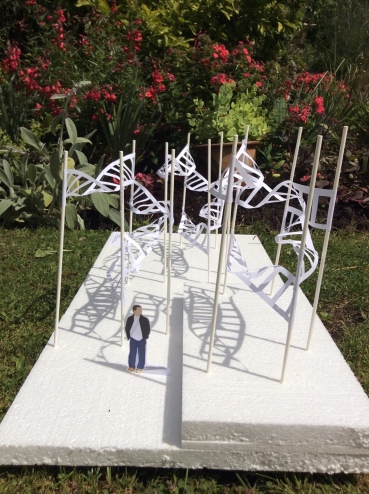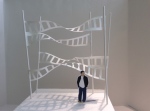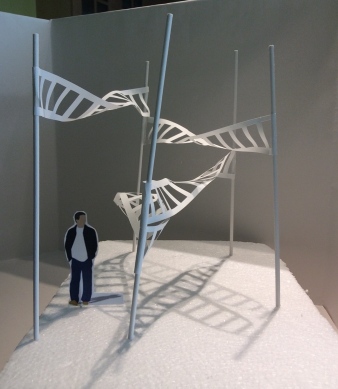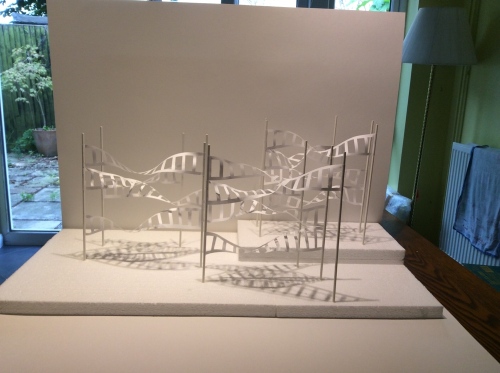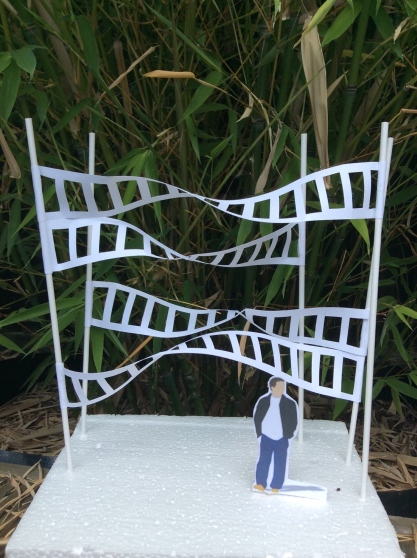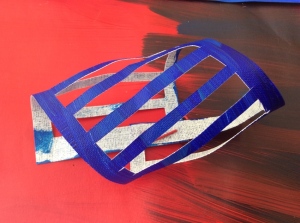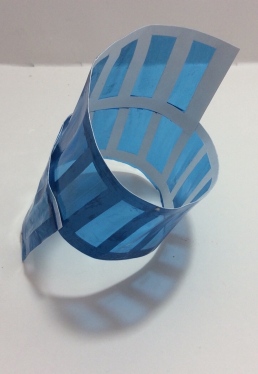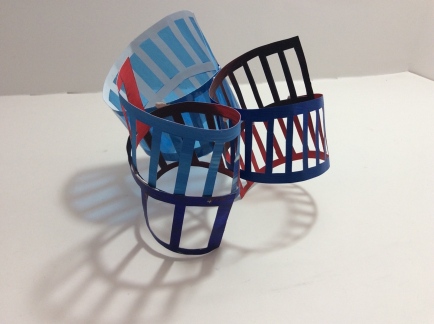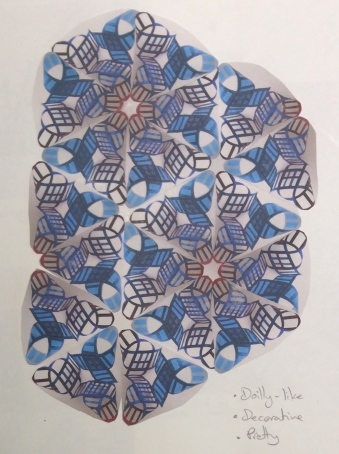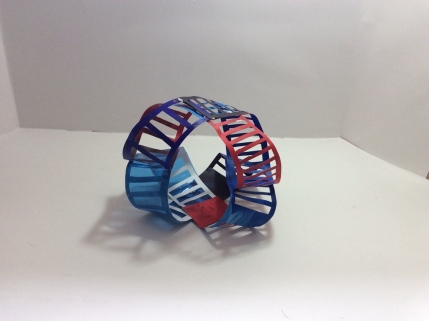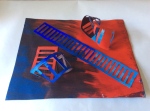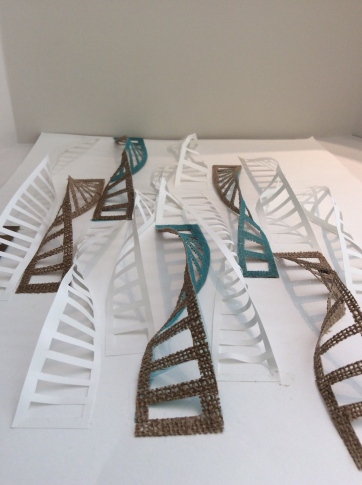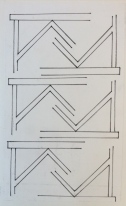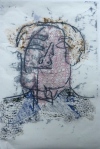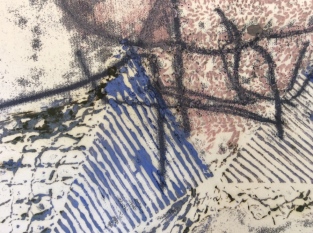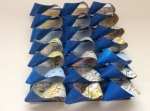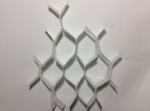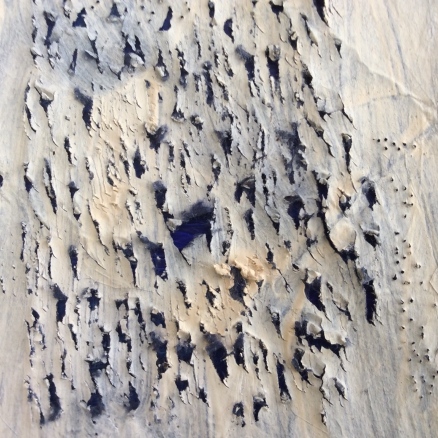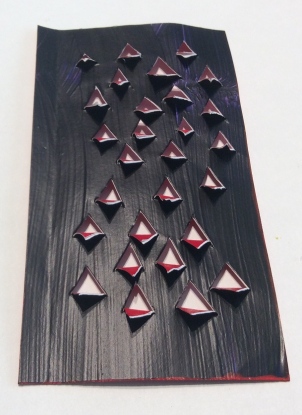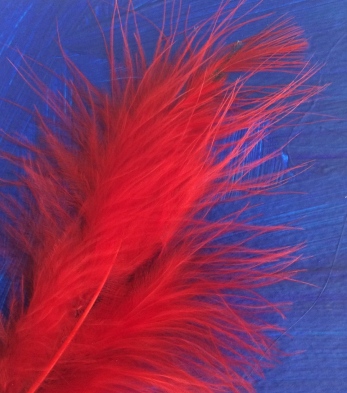28 June 2017
Part 5, Stages 3 to 5 – Sample-making, recording outcomes, sorting (resolving the sample)
The starting point of this phase of work is the output from
experimenting with surfaces: a strip with ladder-like hole cut-outs, and contrasting coloured surfaces (below).
The aim of this stage is to resolve this idea using sampling, and at the end of the process, to have selected the best concept to use for my final piece.
Before I started on the practical work, I conducted some
detailed research specifically targeted at my concept. I looked especially at light and shadow, reflection, architecture and repeating patterns of Islamic design. I wanted to reach beyond the obvious influences of textile practitioners.
I started my practical sampling with an exploration of form. In items 1-6 below, I used either one or more of the strips on the inside back cover of my sketchbook, or the piece of painted cut-out pelmet facing labelled experiment 6.2, at the bottom of page 29 of my sketchbook. Because of time constraints, I simply configured the strips with blu-tac, photographed them and then took them apart to use for the next sample, so samples 1-8 do not physically exist.
1. Spirals
(sketchbook pages 33-38)
I experimented with different lengths of strip, and strips with different sized cut-outs. In each case, I joined the short edges in a way which was “staggered” to produce a spiral effect (see experiment 7.1 below):
I also joined a longer strip in this way, which had blue cellophane stuck to it (experiment 7.2)
A two-sided piece with different coloured surfaces (experiment 7.3)
And one with larger cut-outs (experiment 7.4)
The first sample idea I had was to combine them in a group of three (sample 1 below):
I was disappointed. The shapes had been attractive when viewed singularly, but when placed together there just seemed to be too much going on. The spiral form was lost and the overall image was not easily read. This visual complexity meant that I couldn’t imagine the sample working as part of a constructed surface. I wanted rhythm, easily identifiable repeating units and a sense of surface. The sample provided none of these attributes.
Despite my disappointment, I took note of the beauty of the shadows, especially with regard to the elongation and contraction of the “rungs” of the ladder, and the blue shadow cast by light through the cellophane.
In my sketchbook, I went on to investigate how I might combine spiral elements in column-like arrangements. I looked at stacking them tightly together, or alternatively leaving a space between each element. I thought about increasing the number of twists and changing the diameter of the spirals to make the wider and shorter. On page 36 I explored the effect of scale (see extract from page 36 of my sketchbook below):
Despite these investigations, none of the arrangements excited me; they all seemed very safe and conventional. Also, I felt that I was moving away from the idea of a constructed surface, so I went on to the next idea.
2. Twisted loop
(sketchbook pages 39-42)
The twisted loop is similar to that which is worn as a charity ribbon (for example for AIDs or cancer awareness) – see experiment 8.1, sketchbook page 39.
I first looked a combining a group of three of these twisted loops, joined at the short ends (sample 2). In my sketchbook, I photographed the sample both from above and obliquely, then turned it over and photographed it again from the other way up. The view I most like is shown below (and is from the top left of page 40 of the sketchbook).
The views looking obliquely were difficult to read, but the two from above and below showed the geometry clearly, which I preferred. I also think the cellophane/white paper surface works well in contrast to the other two components which are similar in colour and material.
I then thought about how the image would look tiled:
My initial reaction was that the arrangement was pretty, and I could imagine it as a fabric design. However, I felt that it was too complex and with too much negative space to be turned into a constructed surface.
I also thought about joining the trio in a radial fashion (sketchbook page 42):
I really like the pooling of colour, particularly in the radial design, which reminded me of lacy flowers.
When describing these pieces in my sketchbook, the words, “pretty”, decorative” and “pattern” kept coming up. This intricate laciness was not really what I had in mind for my constructed surface. The word that was missing was “texture”. When joined together these pieces they were evocative of pattern rather than a surface. I also felt a lack of emotional response to the work which made it difficult for me to relate to the piece on anything other than a superficial level (i.e. an appreciation of it as decorative). Another reason why I decided not to continue with this line of enquiry is because the grouping only looks good when viewed from above or below, not obliquely.
Lastly, I considered a different way of attaching the twisted loops, so that they lay flat (sample 3, page 40). I didn’t feel that this arrangement offered any advantages over the ones above, so I decided to move on to the next idea.
Post script:
Looking at the shape afresh (as I write this blog post and with the context and benefit of additional research), I can visualise that with 4 strips, I could have formed a four pointed twist shape, joined at the corners to make an element for a constructed surface.
I have discussed how this would work in my sketchbook, along with how it might be stretched to make a expandable/contractable structure (inserted sheet between pages 40 and 41). It reminds me very much of the vulcanised paper surface used by Kengo Kuma in his
IRORI and paper cocoon (2015) (Kengo Kuma Associates, 1990-2017a), which was my inspiration. However, this configuration only works because I have reverted to using solid strips; it would not have the rigidity or structural integrity to work with cut-outs (and I feel they would also add unnecessary visual complexity). Perhaps this is why the idea did not come to mind as I was working through my samples?
3. “Jelly bean” and figure of eight
(sketchbook pages 43-44)
Both these shapes were inspired by the designs of Ron Arad (Ron Arad Associates, n.d.). The “Jelly bean” (sample 4, sketchbook page 43) was difficult to control when modelled with the paper strip. I could have considered a mouldable material, or a way of stiffening the paper after forming it. However due to time constraints, I did not feel able to continue with this line of investigation. A figure of eight shape, however, could be secured where it crossed over, giving extra stability and rigidity (see below):
Once again, I wasn’t really sure how this shape could be repeated and made into a constructed surface because the cut-outs made it quite complex, and I suspected that the geometry would be ‘lost’ when several shapes were placed together. The only shape that I tried was a “squashed” ball/sphere made by resting one figure of eight the opposite way around on top of another to create a central void (perhaps best illustrated by a photo – sample 4 below):
My initial thought was that the cut-outs made the shape appear rather complex. However, I included a scheme of how similar open spheres might be joined in either aligned or staggered columns on page 44 of my sketchbook.
Post script:
Although I was initially left underwhelmed by the thought of joining spheres to make a surface, writing this blog post gave me the opportunity to revisit the idea. I recalled the
Abu Dhabi Art Pavilion (2013), a building designed by Japanese architect Shigeru Ban (Shigeru Ban Architects, n.d.). Shigeru used stacked cylindrical tubes made of cardboard to form the structure of the pavilion wall, which look similar to bamboo (very natural and in keeping with the surroundings). Being hollow, they provide for visibility and ventilation. However, the surface really comes to life when light falls across the openings of the tubes, casting shadows onto their interior. A different (and even more stunning effect) is obtained when the structure is artificially lit at night. This made me think of my concept in a different (and more positive) way. Because I hadn’t actually made a surface, I hadn’t properly explored the possibility of it being enhanced by light and shadow. Ban’s structure allowed me to consider that a very simple (even basic) construction can be visually very engaging if made with suitable materials and placed in the right surroundings.
4. Mobius strip
(sketchbook page 45)
The structure which I was most disappointed with was the Mobius strip. The cut-outs made the shape visually ambiguous, especially when viewed as a group (sample 5, sketchbook page 45 – below)
The grouping has the appearance of a tangled pile of metal with no clarity of form. I could have reverted to a solid paper strip which I knew from my earlier work would produce a more structured surface. However, I felt that there wasn’t enough scope for development with this line of enquiry.
5. Stacked cylinders
(sketchbook page 46)
The idea for this arrangement of the strips came from a
building with offset floors (Chen, 2017). I was also seeking a very simple configuration, which might be more suitable for a constructed surface. I joined the short ends of each of three strips together then stacked them end to end (sample 6, page 46 – below)
It seemed a little lack-lustre, and in any case the structure was not stable. Without any excitement generated, it didn’t seem worth spending the effort of solving the problem of how to join the pieces.
6. Simple twisted strip
(sketchbook pages 47-54)
Searching again for simplicity, I had the idea of making a single twist in the strip, exposing both the upper surface and (the different coloured) underneath. I made two different arrangement of these strips:
a) Twisted in opposite directions (sample 7, page 47)
b) Twisted in the same direction (sample 8, page 48)
In each case the negative spaces were similar, but the strips twisted in the same direction had a more harmonious feel.
The samples reminded of a fabric sculpture by Japanese artist Masae Bamba called
“Floating letters, falling words” (Taylor, 2013). In this work, pieces of Indigo dyes cloth are arranged on the floor to give the impression of ripples on water (a rhythmic disturbance of the surface). Bamba also associated the concept of water with pregnancy, and included printed “nonsense” characters which had been made by her daughter when she was learning to write. The piece was clearly very personal to the artist, however it was the concepts of transition, rhythm, repetition and the associated feeling of calmness and wellbeing which attracted me most. I hoped that I could create a similar response from my twisted strips if I arranged them in staggered rows to form a surface.
First, I did some sketchbook work – drawing the samples to understand their form, thinking about how I might arrange them and how I might use colour on the two surfaces. Unlike samples 1-8, this concept had the potential to create texture. I wanted movement, rhythm, gentle undulation, and a surface which would change depending on the direction from which it was viewed (inspired by both the architecture and Rana Begum’s
“Space, Light, Colour” exhibition) (Sainsbury’s Centre for the visual arts, n.d.), and the “Pavilion” series of architect
Kengo Kuma (Kengo Kuma and Associates, 1990-2017d).
I also wanted to use the idea of similar and contrasting background colours to make areas of my sample seem to either “melt into the background” or “jump out into the foreground” respectively. This was an attribute which I had identified in experiment 6.3 (page 30 of my sketchbook – see thumbnail below)
Mindful of the Japanese aesthetic of sensitivity to nature and the use of natural materials, I chose paper, hessian and silk for my sample. Paper also served the purpose of being readily available and an easy way to incorporate an identical material for both the background and the strips.
Referring to my contextual research, I had been particularly intrigued by the way that Japanese architect Kengo Kuma combined natural and synthetic materials in his structures (examples being
“Ceramic Yin Yang” (2010), an installation contrasting ceramic pieces with a nylon organza curtain, and
“Wind Eaves” (2015) a pavilion/shelter structure made of wood and covered with a fluorine-based plastic membrane). (Kengo Kuma and Associates, 1990-2017b, Kengo Kuma Associates, 1990-2017c) In “Ceramic Yin Yang”, the organza was used in a way which reminded me of sheets of water flowing down a waterfall or water feature, so I decided that it would be an appropriate material for my sculpture.
I started by conducting some experiments with stiffening and bonding fabrics to see if I could achieve a 2-layered strip with different colour/textural attributes each side (experiments 8.1 and 8.2, sketchbook pages 51-52). In general the method worked well, although there was some fraying of the edges of the silk and tweed in particular, which I wanted to avoid to keep the edges smooth, crisp and well defined.
Layering of the organza worked well, providing colour modulation and sparkle. I also particularly liked the pattern created by light and shadow with the hessian pieces (see below):
The photograph above shows that bonding organza to the hessian created a soft blue shadow which still exhibited the pattern of the hessian weave.
Next, I used my sketchbook to examine the effect of different layout patterns, and twisting the strips either the same direction or differently (sketchbook pages 50 and 51). I found that a mixture of twists in both directions, and strips of varying lengths gave a more dynamic feel, so this was my choice for the sample.
Due to the size and stiffness of the materials I was using, the smallest sample which I could made was A2 size. I needed to keep the twisted strips in place, so I glued each of the short ends to the paper background (see sample 9 below):
In the photograph above, the sample has been placed against a wall (in the same way that a picture would be hung). This has created beautiful shadows. However, my initial concept was for it to be placed on a flat table surface so that the viewer could walk around it and observe the surface from different angles. Intentionally, this gives a very different visual effect, because the different coloured surfaces and twists ensure that virtually none of the blue organza surface is seen for one direction, yet from the opposite side almost all of it is visible (compare the two photos below).
Looking down the length of the strips also produces a different feel to the piece.
Next, I considered what would happen if I flexed and disrupted the background paper. Because the strips were in tension, it was only possible to bend the surface inwards. However, the results were stunning, as the strips seemed to free themselves from the constraints of their mounting (see below)
Because the white paper strips are of identical material to the background, I don’t find this image visually confusing. Instead, I find myself rather fascinated that the strips are only visually defined only by a variation in tone and by their shadows. This makes for a very subtle effect.
This configuration gave me the idea of taking the concept a stage further; to come up with a way in which the strips could be completely removed from their background surface and used to make three dimensional sculpture. I recalled the beautiful and intricate paper sculptures of Japanese artist Katsumi Hayakawa, in particular
“Floating city” (2011) which is suspended in mid air to create delicate shadows on the gallery floor.
I had the idea of attaching the short edges of the strips to poles which could be secured to a base in three dimensions. I only had five construction straws available (why didn’t I buy more!), so this constrained my sample.
I was instantly struck with the feeling of movement. Rather than waves on water, the sample now felt more akin to waves in the air; soft, gentle and undulating, it seemed to suggest wind (or maybe the movement of clouds through the sky?) I also made a connection with weaving; the vertical poles representing the warp and the horizontal strips the weft. The presence of negative space between the strips made me think, in particular of the characteristic style of Sheila Hicks.
I photographed the sample from different positions and under multi-directional spotlights and it became even more intriguing (see below, sample 11).
One feature which I found especially engaging was the idea that the viewer would be able to walk through my piece (for a more interactive experience), rather than simply just walking around it. This gave me the idea of changing the scale, and considering possibly placing the sculpture outdoors (or at least in a vey large gallery space). I placed different sized paper figures next to my sample until I found a size where the scale felt comfortable (see below).
7. “Disrupted” ladder rungs
(sketchbook pages 55-58)
This idea came from a piece of painted pelmet vilene which was left crinkled and creased after it had been used for experimentation (see below):
Thinking about Rana Begum’s exhibition (Sainsbury’s Centre for the visual arts, n.d.), and in particular, her use of fluorescents to reflect coloured light onto an adjacent surface, I decided to paint the underside of my sample in fluorescent paint to see if I could replicate the effect. I also varied the blue colour across the upper surface surface to produce a subtle sense of transition.
To make the constructed surface, I joined (sewed together) pieces in a similar fashion to patchwork. To make the “rungs” more inclined to buckle, I slightly curved the surface of one of the pieces, to make sure that when sewn together they wouldn’t rest flat (see sketchbook, bottom of page 56)
The result took me somewhat by surprise! (see sample 10 below)
I was not expecting the reflections to be anything like as bright. It was a stunning and engaging piece, however there was a conflict between the pink fluorescent and the yellow and green (which are closer to blue on the colour wheel). If I were to develop the idea further, I would restrict myself to fluorescent green (it being an analogous colour to blue). I also felt that there was too much of the “disrupted surface” and thought about placing uncut sections within the surface to break up the pattern and relieve the eye. I have recorded these ideas in my sketchbook, along with some experiments into strips which might be incorporated (sparingly!) (see sketchbook page 58).
Sorting:
Samples 1-6 felt too pattern-based and not sufficiently textural to use for a constructed surface. Once the penny dropped, I was able to change tack and simplify my approach. Samples 7 and 8 followed, and I developed this line of enquiry first to produce sample 9, then sample 11.
Sample 10 was also very simple in concept and drew on the idea of using reflected light to cast coloured shadows beneath a surface. Although there were too many conflicting fluorescent colours, I have shown in my sketchbook that it could be simplified and developed to make what I think would be an excellent final piece. Similarly, sample 9 could make a successful final piece by using more of the same sized pieces on a larger surface and perhaps introducing more subtle variations in the colour. However, it was sample 11 which spoke to me loudest.
Sample 11 is a more more free version of sample 9; it suggests subtly, sensitivity and calmness. It is three dimensional and can be configured to different settings. It has the potential to be considered for indoor or outdoor installation.
The sample clearly works very well with white paper strips, but I wonder if it might be further enhanced by the addition of accents strips of organza (white, or perhaps even blue?) Thinking about developing it into my prototype/maquette, I would also consider repeating the structure to make a larger piece, configuration (expansion or contraction), placement and materials.
References:












